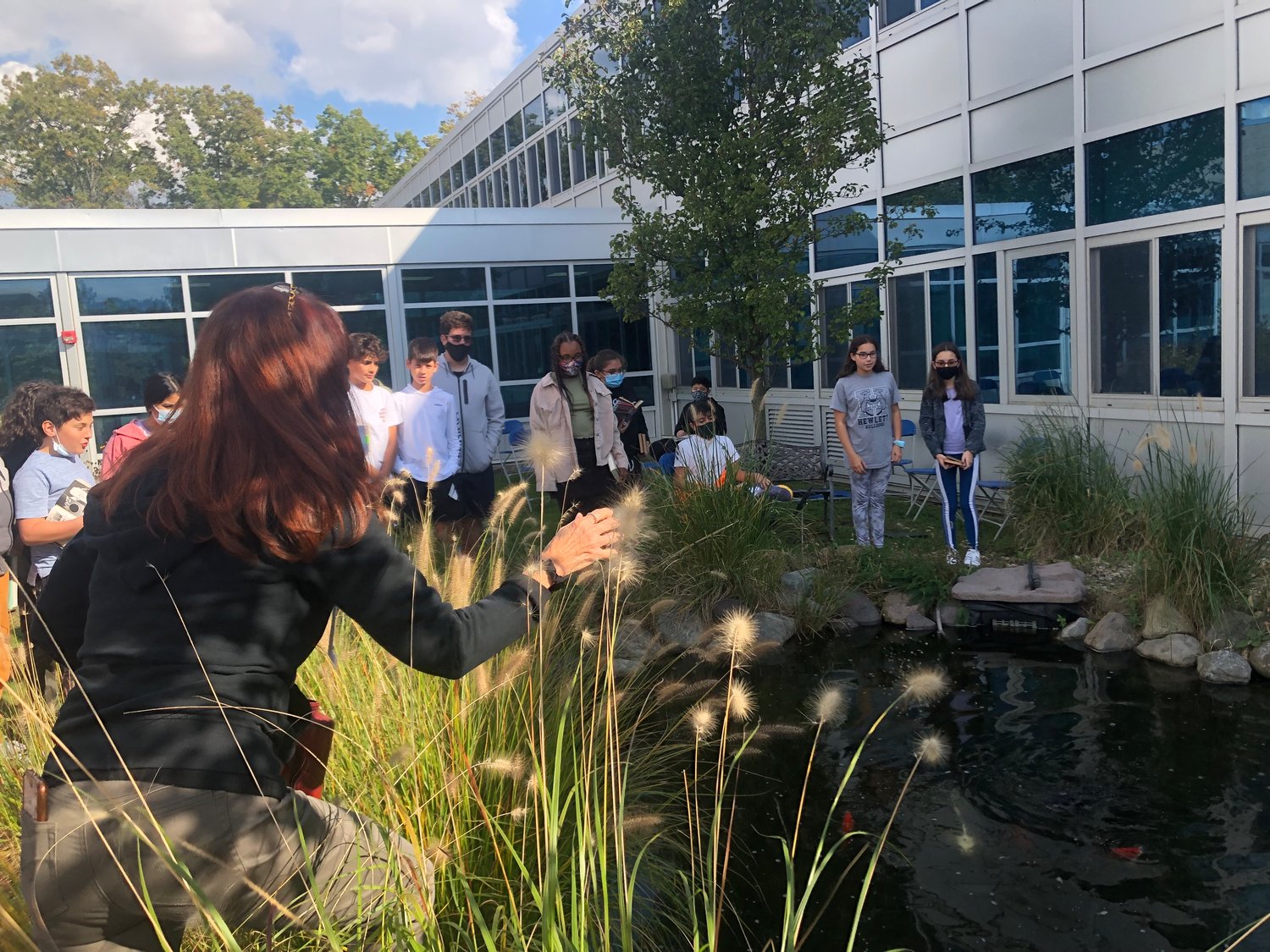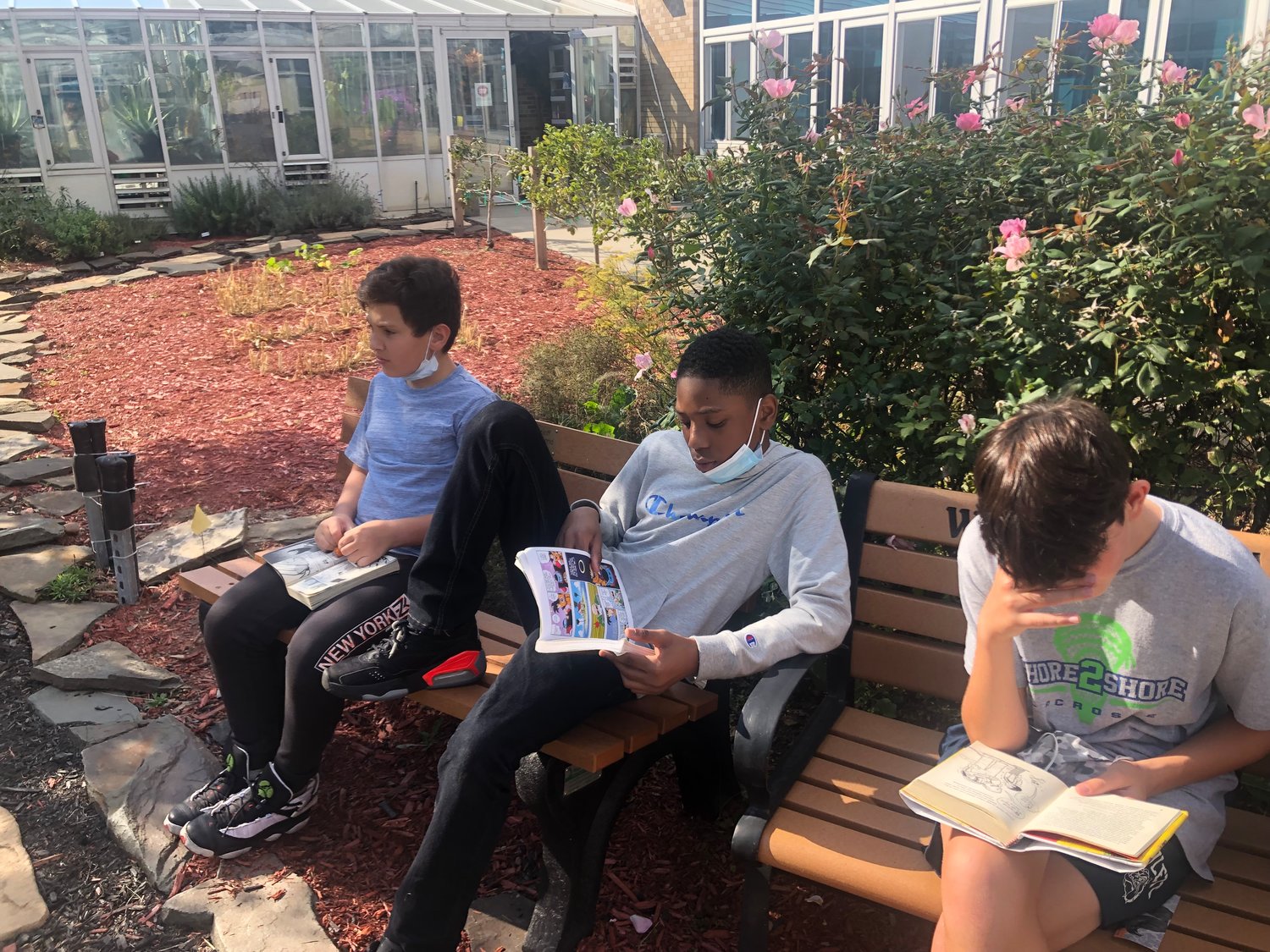Environmental center is Hewlett-Woodmere district gem
The Woodmere Middle School Environmental Center, which used to be a weedy, concrete courtyard, blooms beautifully in the spring and is a popular hands-on learning spot for the school’s social studies, math, science, English, music, art and special-education programs.
Science Chairman Dr. Brian Terry has been involved with the environmental center since the summer of 2013. Terry said that the Environmental Pond, built in memory of Woodmere student Robert Faller, who died in a 1990 helicopter crash, led to the idea of an environmental center in 2011, when the Hewlett-Woodmere School District’s now-retired Superintendant for Business, Dr. Peter Weber, oversaw the beginnings of the courtyard’s makeover.
Eric Scott, a former zookeeper, joined Weber in the effort when Scott was hired as a custodian in 2002. Since then, he has taken a leading role in beautifying the space. In April 2016, Nassau BOCES presented Scott with the Partner in Education Award for benefiting Woodmere education with his creative efforts at the center.
His most recent addition was apple trees, planted in 2019, which are being guided by wires to grow in a way that allows students with disabilities to reach the blooming fruit.
Seventh- and eighth-grade science teacher Dr. Kenneth Mossey started working at the environmental center in 2014, and spends two periods a day coordinating curriculum in the greenhouse.
“The administration has been amazing in letting us go where we want to go with this project,” Mossey said. “The kids seem to love it, and it’s a pretty cool space.”
Scott is credited for successes in the bird and butterfly garden, which is populated by bird- and pollinator-attracting plants native to Long Island.
In 2017, the garden was registered by the University of Kansas’s Monarch Watch Entomology Program as a monarch way station, because the garden grows milkweed, the endangered butterflies’ dietary mainstay. The plant is commercially hard to find, but was found naturally by Scott and harvested from Motts Creek, along the back of the middle school.
The garden also has nectar sources and shelter needed to sustain the monarchs. In the spring of 2018, pre-K students from Franklin Early Childhood Center in Hewlett released their classroom-raised monarchs into the butterfly-friendly ecosystem.
Ogden Elementary School and Hewlett Elementary School third-graders came to the pond in 2019 for a lesson on camouflage and natural selection in the ecosystem, observing the different-colored bass, bluegills and other fish in the pond.
Because it is such a unique space, the environmental center has welcomed visitors from outside the district. The most recent — before the pandemic —were from schools in Cold Spring Harbor, Half Hollow Hills, Levittown, Long Beach and Plainedge.
Although most plants in the courtyard wither during the cold months, those in the center’s greenhouse — a black pepper plant, a cocoa tree, a fig tree, a coffee plant, Venus fly traps, an ample collection of cacti and other succulents — thrive all year long.
The greenhouse has at least four different planting systems that simulate biomes, from desert to tropical. They include a hydroponic scroll wall system, a clay-bead aquaponic system — when the large-mouth bass get too big to stay in that system, they move to the pond — and a carnivorous bog planter.
The middle school’s math and science departments frequently use the greenhouse for experiments, learning methods of data collection and analysis. The social studies department does a history lesson in the greenhouse called the Three Sisters project, in which students plant corn, beans and squash, staples of Native Americans.
During the warmer months, English, music, art, social studies, foreign language and special-education classes have been held outside in the environmental center, which has space for as many as three classes at once.
“Any teacher that we can get to use the space, we’re all about them using it for whatever purpose they want,” Mossey said. “We designed it to be an outside classroom.”
Teaching assistant Theresa Kearney has worked in the center since 2015, and helps Mossey with greenhouse lessons. Her favorite part? “I have to say, being with the kids out here,” Kearney said, “because they ask a thousand questions and are just really inquisitive and interested in what goes on.”
While the middle school was shut down by the pandemic, the environmental center kept students from missing out, distributing bags filled with supplies to grow radishes to every fourth-grader in the Hewlett-Woodmere district.
“There was a QR code on the outside of the bag that, when you click on it, it would show a video step by step of what to do,” Terry said, “and the kids loved it.”
Entire classes can’t squeeze into the greenhouse anymore, due to Covid guidelines: Only six masked, socially distanced students can be inside at once. But there’s been a good side to the pandemic as well. More teachers have been using the outdoor space for activities.
After a trip to the school’s library on Oct. 22, Linda O’Grady’s seventh-grade ELA class gathered outside at the center and sat in the sun, reading.
One student, Liev Hecht, read by the pond. “You get to experience what’s outside — not just in a classroom, sitting down all the time,” Liev said. “You get to have the sun, or wherever you want to sit out here.”

 39.0°,
Fair
39.0°,
Fair 







